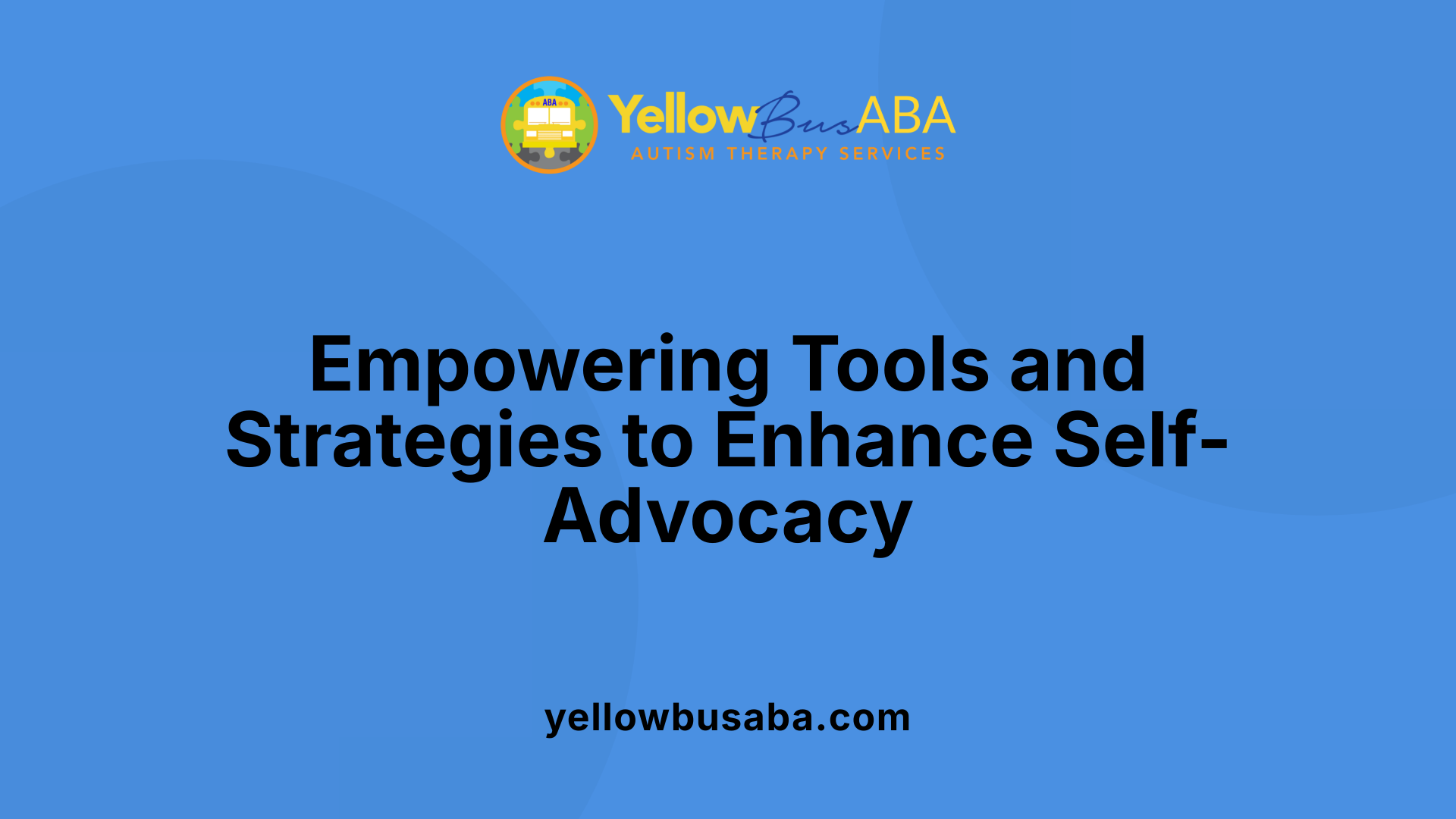Understanding the Significance of Self-Advocacy in Neurodiversity
Self-advocacy is a vital component of personal independence and well-being for individuals with autism and other neurodivergent conditions. It involves the ability to understand one’s needs, rights, and preferences, and communicate them effectively. Developing self-advocacy from a young age fosters confidence, resilience, and self-awareness, crucial for navigating societal barriers and accessing necessary accommodations. Enhancing these skills improves quality of life and supports genuine inclusion in various settings, including education, employment, and social relationships.
Foundations and Principles of ABA in Self-Advocacy Development

Why is fostering self-advocacy important for individuals with autism and neurodiverse conditions?
Fostering self-advocacy is essential because it empowers individuals to express their needs, rights, and preferences confidently. This ability leads to greater independence and a higher quality of life.
Self-advocacy skills enable children and adults to access vital accommodations and resources they require in educational, social, and professional settings. It also encourages active participation in decisions about their care and future plans.
Developing these skills builds confidence, resilience, and self-awareness, which help individuals navigate societal challenges and combat ableist attitudes.
Moreover, self-advocacy enhances mental health by supporting self-determination and fostering positive social interactions. It allows individuals to feel recognized and included, promoting overall well-being.
In summary, nurturing self-advocacy supports meaningful inclusion and equal opportunities, leading to more empowered, autonomous lives for neurodiverse individuals.
Basic principles of ABA and its role in behavior change
Applied Behavior Analysis (ABA) is built on understanding how environmental factors influence behavior. Its main approach involves systematically examining the connection between behavior and environment to promote positive change.
Core techniques include positive reinforcement, which rewards desired behaviors to encourage their recurrence. ABA uses tools like task analysis and visual supports to teach new skills and diminish problematic behaviors.
When aimed at developing self-advocacy, ABA emphasizes not just compliance but active participation, problem-solving, and effective communication.
ABA therapy integrates various strategies such as role-playing, social narratives, and modeling to teach social cues, self-awareness, and decision-making.
Shift from compliance to self-advocacy focus in ABA
Traditional ABA approaches often focused narrowly on compliance, sometimes causing harm by suppressing rather than understanding a child's needs.
Modern practices emphasize respect for the individual’s voice and encourage authentic self-expression. The goal is to foster independence, confidence, and the ability to advocate for oneself.
This shift involves embedding advocacy skills into everyday routines and natural environments, supported by person-centered planning.
Teaching involves providing choices, role-playing scenarios, and reinforcing efforts that reflect bravery and effort, not just obedience.
Individualized and person-centered interventions
Every individual is unique, and ABA programs are tailored accordingly. Person-centered planning involves collaborating with clients and families to identify personal goals, dreams, and interests.
Interventions focus on empowering clients to recognize and communicate their needs, set goals, and participate actively in decision-making.
Visual supports, communication tools like PECS and speech devices, and strategies like fading and priming are used to support each person’s preferred communication styles.
Parents and caregivers play a crucial role by reinforcing these skills at home and in community settings. Overall, individualized approaches foster genuine self-advocacy and promote lifetime independence.
Communication as the Cornerstone of Self-Advocacy

What techniques can be used to teach communication, education, and self-awareness to support self-advocacy development?
Effective self-advocacy begins with strong communication skills. To foster these skills, a variety of techniques are employed to ensure individuals can express their needs and preferences confidently.
One approach involves using social stories and visual supports, which help clarify social expectations and enhance understanding. These tools are especially helpful for children who may find spoken language challenging, providing clear, visual cues to guide behavior.
Role-playing exercises are another effective method, allowing individuals to practice real-life scenarios where they need to advocate for themselves. This hands-on experience builds confidence and teaches appropriate ways to communicate needs, ask for help, or set boundaries.
Direct instruction on legal rights, available accommodations, and personal self-knowledge is vital for empowering individuals to understand their rights and responsibilities. Such education fosters awareness about what they are entitled to and how to assert it.
Building a support system involves peer support groups and accessible resources such as workshops and tailored materials designed to meet individual needs. These resources reinforce self-advocacy skills and provide ongoing encouragement.
Integrating self-advocacy training into educational settings ensures consistency and supports during transitions between school levels. Teacher training and individualized planning help solidify these skills across different environments.
By combining skills development, legal literacy, and continuous support, individuals are better equipped to advocate for themselves independently throughout their lives, leading to greater confidence and autonomy.
Tools and Strategies to Foster Self-Advocacy in ABA Therapy

What tools and approaches are commonly used in ABA therapy to empower individuals to advocate for themselves?
ABA therapy employs a variety of tools and approaches designed to strengthen communication, self-awareness, and independence, all vital components of self-advocacy. Visual supports such as emotion thermometers help children identify and express their feelings, while communication cards enable them to clearly convey needs and preferences.
Augmentative and alternative communication (AAC) devices, like Proloquo2Go, expand expressive abilities beyond spoken words, supporting children who struggle with verbal communication. Social stories and staged scenarios are used to teach appropriate responses and advocacy behaviors through familiar, relatable narratives.
Role-playing and modeling are essential techniques for practicing advocating in safe, controlled environments. These methods involve demonstrating self-advocacy behaviors, such as requesting a break or stating a need, which children can imitate and internalize.
Personalized tools like 'About Me' books and sensory scales promote self-understanding. They help children recognize their strengths and sensitivities, empowering them to articulate their needs confidently.
Teaching specific requesting skills is fundamental. Children learn to ask for accommodations, assistance, or changes in their environment effectively. Recognizing escalation cues is also crucial to prevent overwhelm, and problem-solving strategies are introduced to help children navigate challenges independently.
In addition to direct teaching techniques, resource organizations like the Autism Self Advocacy Network (ASAN) provide toolkits that support ongoing learning and advocacy practice. Real-life practice in staged settings helps children generalize these skills across different environments, fostering genuine self-advocacy.
Overall, these tools and strategies work together to build foundational skills that enable individuals with autism and other neurodivergence to stand up for themselves confidently and effectively in daily situations.
Embedding Self-Advocacy in Daily Environments and Educational Settings
 Promoting self-advocacy skills in children and neurodivergent individuals involves integrating practices across natural environments and educational contexts. One effective strategy is practicing self-advocacy within everyday settings, such as family routines, peer interactions, and community activities. For instance, children can learn to communicate sensory needs, request assistance, or set boundaries when playing with friends or participating in family routines.
Promoting self-advocacy skills in children and neurodivergent individuals involves integrating practices across natural environments and educational contexts. One effective strategy is practicing self-advocacy within everyday settings, such as family routines, peer interactions, and community activities. For instance, children can learn to communicate sensory needs, request assistance, or set boundaries when playing with friends or participating in family routines.
Explicit inclusion of self-advocacy goals in Individualized Education Programs (IEPs) and daily planning ensures that these skills are prioritized and systematically taught. This might involve actively involving children in discussions about their learning preferences, accommodations, and personal development goals. Including children in decision-making processes fosters a sense of ownership and builds confidence.
Recognizing and asserting personal boundaries is a vital component of self-advocacy. Teaching children to understand their physical and emotional limits, and how to assert these boundaries respectfully, prepares them for safe interactions and self-protection.
To effectively develop these skills through ABA therapy, various methods are employed. Role-playing scenarios allow children to rehearse advocating for themselves in a variety of situations, such as asking to take a break or expressing discomfort.
Social stories and visual supports help children learn appropriate ways to communicate their needs, while priming prepares them for upcoming social interactions. Modeling positive behavior by caregivers and therapists demonstrates how to assert oneself respectfully and confidently.
Providing positive reinforcement for self-advocacy efforts encourages ongoing practice and internalization of these skills. Tailoring interventions to individual needs and ensuring collaboration among team members—including families, teachers, and therapists—are crucial for success.
By embedding these practices into daily routines and educational planning, children become more autonomous, confident, and capable of managing their needs effectively in a range of environments.
Training and Guidance for Caregivers and Professionals

What are best practices for therapists, parents, and caregivers to encourage self-advocacy through ABA interventions?
Promoting self-advocacy in children, especially those with neurodivergent profiles, requires a collaborative and person-centered approach. Therapists, parents, and caregivers should prioritize developing advocacy-driven goals that truly reflect the child’s own wishes, interests, and rights. This involves actively listening to the child’s communication—whether through gestures, speech, assistive devices, or body language—and respecting their choices.
Embedding skill-building in natural environments is essential. This means practicing communication, decision-making, and problem-solving in settings like home, school, or community outings, so children learn how to navigate real-life situations confidently. Using tools such as picture exchange communication systems (PECS), speech-generating devices, and sign language helps support genuine, accessible communication.
Modeling positive advocacy behaviors is one of the most effective strategies. Caregivers and therapists should demonstrate how to request help, express preferences, and set boundaries—showing that self-advocacy is both powerful and normal. Providing opportunities for children to make choices—like selecting activities or discussing preferences—encourages independence and decision-making skills.
Collaboration among families, educational teams, and outside professionals ensures consistency and reinforcement of advocacy skills across settings. Regular team meetings to align strategies and share progress help support the child’s growth.
A neurodiversity-affirming approach is fundamental. Shifting focus from control or compliance to collaboration respects the child’s individuality and promotes self-esteem. This entails honoring all forms of communication, endorsing their right to express themselves, and creating safe spaces for children to practice asserting their needs.
Finally, providing accessible resources, ongoing guidance, and structured practice opportunities empowers children to become confident self-advocates. Role-playing scenarios, visual supports, and social narratives are valuable tools to teach and reinforce advocacy skills, strengthening their capacity to manage challenges and embrace their independence.
In summary, best practices encompass active listening, respecting choices, person-centered planning, modeling positive advocacy, embedding skills in natural settings, and fostering a supportive, neurodiverse-affirming environment—all reinforced through continuous collaboration and resources. These strategies not only bolster self-advocacy but also pave the way for children to develop a strong sense of identity and control over their lives.
Cultivating Autonomous Advocates for Life
Building self-advocacy skills through ABA therapy requires a comprehensive, individualized approach that prioritizes communication, self-awareness, and natural environment integration. Empowering neurodiverse individuals to express their needs, set goals, and participate actively in their life decisions fosters independence, confidence, and resilience. Collaboration among therapists, parents, caregivers, and the individuals themselves is essential to reinforce advocacy skills across contexts and stages of development. Embracing neurodiversity-affirming practices and shifting from compliance-focused tactics to respectful, person-centered strategies create a supportive foundation for lifelong self-advocacy, ultimately contributing to a more inclusive and equitable society.
References
- Self-Advocacy Skills for Children with Disabilities - Clinical Behavior
- 3 Solutions for Teaching Self-Advocacy in ABA to Autistic and ...
- Self-Advocacy Skills: How TWC Helps Children Express Their Needs
- Episode 189: Teaching Self-Advocacy - How to ABA
- Self-advocacy: helping children speak up for themselves
- Building Self-Advocacy Skills in Students with Autism
- 5 Helpful Self-Advocacy Tips For Neurodiverse Kids at School and ...
- ABA Therapy for Leadership Skills: Empowering Children



.jpg)

.avif)
